
Is Cartagena de Indias Colombia’s most beautiful city? Many say yes. Some even whisper that it’s the most beautiful in the world. With its vibrant colonial architecture set against the turquoise Caribbean Sea, it’s easy to see why.
For independent explorers, this walkable wonderland is a dream come true. With its rich history, Caribbean vibe and delicious cuisine, Cartagena is an ideal destination for those seeking cultural immersion, relaxation and adventure. Beyond the iconic landmarks lie hidden stories and secret spots waiting to be discovered…
Our independent traveler’s guide contains 21 top picks of things to do in Cartagena and in its surroundings. Get ready for an unforgettable Caribbean adventure!
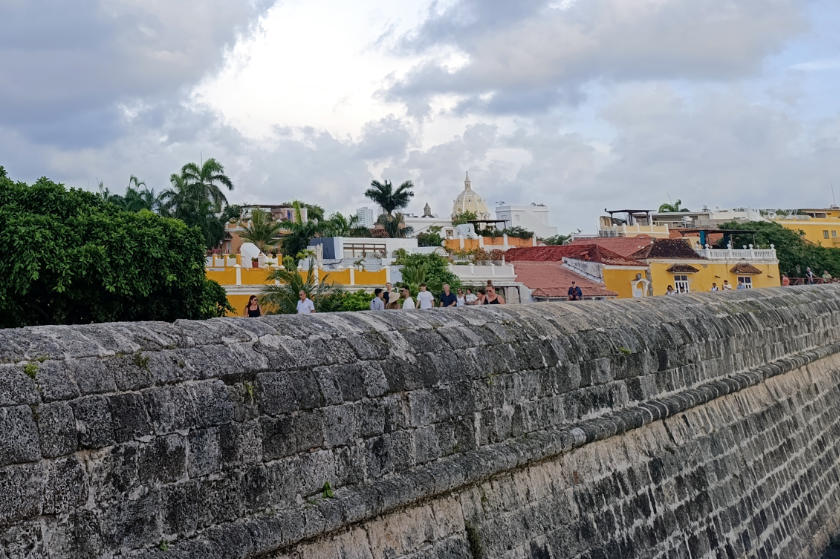
Photo by Travelhapp, Old Town, Walled City Cartagena Colombia
The 16th century San Felipe de Barajas fortress was built by the Spanish colonizers on the Hill of San Lázaro to defend Cartagena from attacks by the English, French, and Dutch and by sea pirates. This imposing site overlooks the city and the harbor.
While strolling along the fortress walls, you can enjoy the refreshing sea breeze and have a breathtaking view of Cartagena. There are also fascinating underground tunnels to explore. You can book a free tour of the Castillo San Felipe de Barajas online at Civitatis.com*.

Photo by Elijah Lovkoff, view from San Felipe de Barajas Fortress Cartagena
Enjoy ceviche, fresh fish, lobster with coconut rice, Cazuela de Mariscos or other typical Caribbean dishes in one of Cartagena’s fine restaurants. On Civitatis you can also book a free food tour*.
Here are some recommendations for best places to go. It is often a good idea to book in advance.
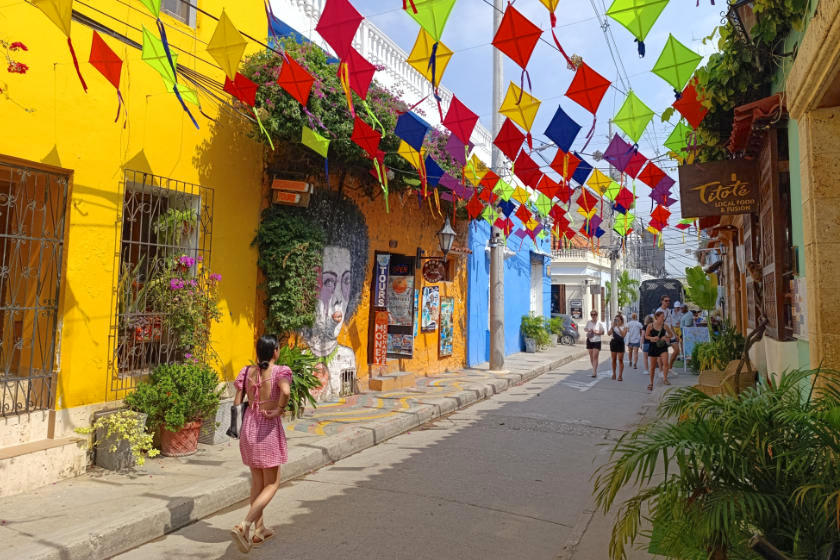
Photo by Travelhapp, Getsemani Cartagena
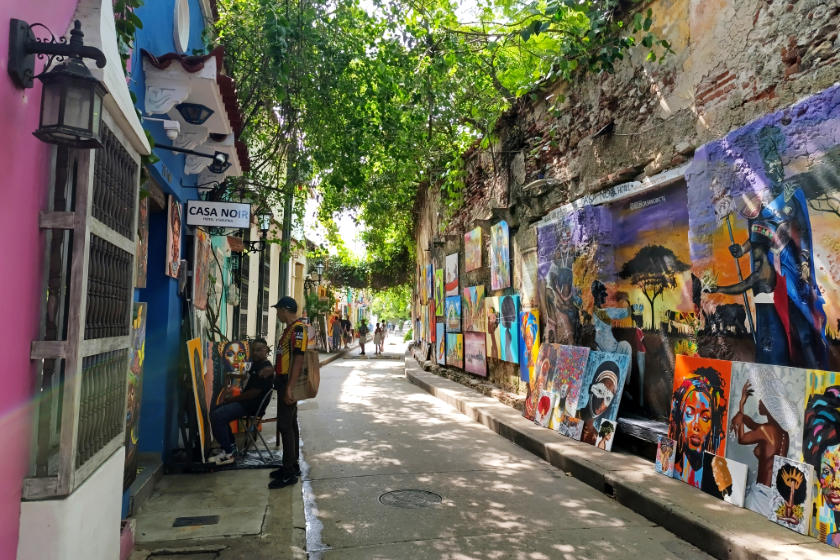
Photo by Travelhapp, Art in Getsemani Cartagena
Parque del Centenario is a green park between the Old Town and Getsemani, inspired by the Luxembourg Gardens in Paris, and honoring Colombian independence fighters. It’s a popular local hang out and a little urban oasis for wildlife spotting. You may catch a glimpse of Andean squirrels, grey titi monkeys, Iguanas, or even sloths.
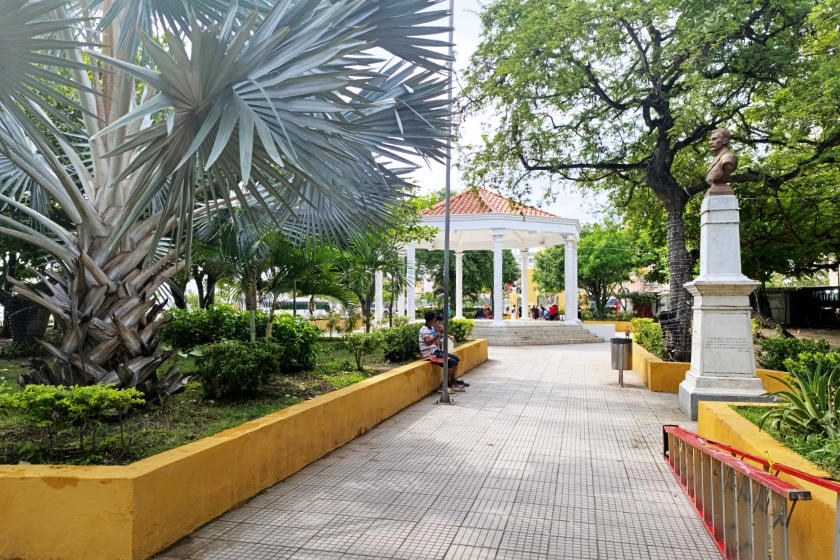
Photo by Travelhapp, Parque Centenario Cartagena
The beautiful La Popa Monastery, originally built by the Augustinian order around 1610, is located on the highest hill in Cartagena and offers beautiful views of the city and the Caribbean sea. It’s recommended to hike up the hill in a group for safety reasons (or book a taxi/Uber).

Photo by Elijah Lovkoff, La Popa Convent Cartagena Colombia
Cartagena offers museums to suit every taste, some of them are even free. A museum visit is also a great way to pass the hottest hours of the day, or to do something interesting when it rains in Cartagena. Here is a selection of some of the best museums in Cartagena:
Museum of the Inquisition: Visiting the Palace of the Inquisition and its museum in Cartagena’s Old Town is a must for people interested in history. The museum teaches you about the cruel methods and tools of the Spanish Inquisition and their impact on the Colombian people.
Zenú Gold Museum (Museo del Oro Zenú) This free museum, hosted in a colonial mansion, exhibits artifacts spanning 6000 years of pre-Hispanic culture and history in the Colombian Caribbean region. Its highlight is an impressive collection of gold and tumbaga objects, crafted by the Zenú indigenous people who lived in Colombia regions prior to the arrival of the Spanish.
Casa Museo Rafael Núñez: The house of former Colombian president Rafael Núñez, a beautiful historic building in the Cabrera neighborhood, has been turned into a museum and showcases his remarkable life through period furniture, documents, photographs, and personal objects. Admission is free.
Modern Art Museum of Cartagena: The Museo de Arte Moderno Cartagena is an ideal destination to explore Cartagena’s art scene with its emphasis on local artists.
Museo Naval del Caribe: Uncover tales of pirates, naval battles, and seafaring adventures at the Museo Naval del Caribe in Cartagena, which is dedicated to the rich maritime heritage of the Caribbean region.
A free walking tour in Cartagena is a great way to learn a bit about the city’s fascinating history and present day situation, and to meet other solo travelers.
Check out Civitatis for free walking tours in Cartagena*. If you enjoyed the tour, leave a tip to show your appreciation.

Photo by Travelhapp, Walking Tour Cartagena Colombia
The Getsemaní neighborhood is often said to have the best nightlife in Cartagena. Enjoy the vibrant atmosphere at Plaza de la Trinidad in Getsemani, where locals and visitors gather at night to experience live music and dance performances by local artists.
Dancing is not an option in Cartagena, it’s a must! For Salsa, visit the renowned Cafe Havana in Getsemaní. A Champeta dance class (Viator.com)* is a great way to dive into Cartagena’s Afro-Colombian culture and a really fun thing to do in Cartagena. Champeta is a vibrant style born in Cartagena’s neighborhoods.
If you are looking for an unusual and a little more upscale evening activity, you could try a Rum and Chocolate tasting. Several hotels and restaurants offer this experience in Cartagena, guided by professional sommeliers. Try Caffe Lunatico (Viator.com*).
Please keep in mind that in Colombia it is always advisable to book a taxi or a service like Uber when moving around at night. Do as the Colombians do. If you are staying in the Old Town or Getsemani and want to go out at night you can look for a hostel or hotel in the nightlife area.
A very unique thing to do in Cartagena is taking a cooking class. Discover regional ingredients and learn to prepare delicious local dishes that blend indigenous, African, Spanish and Caribbean influences.
Here are two great cooking classes you can book online via Viator.com*:
Taking a graffiti tour is a really cool thing to do in Cartagena. Cartagena has a vibrant, socially and politically conscious graffiti and street art scene with Dj Lu being one of its most known exponents. You can admire street art everywhere in the city, but Getsemani and San Diego have an especially high density of quality art works.
Who of you still knows the soccer player on the right in the image below?
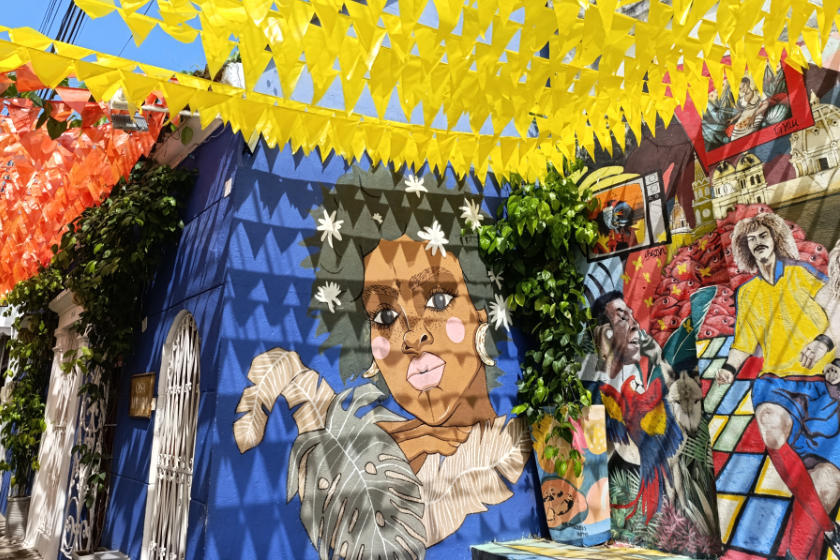
Photo by Travelhapp, Getsemani Street Art Cartagena
The neighborhoods Manga and El Cabrero are located close to the Old City and Getsemani, offering a less busy atmosphere. Manga is a colonial neighborhood where you can admire beautiful historic buildings while walking under the shade of trees. There is also a historic cemetery worth visiting and a sailboat harbor (Club Náutico Marina). El Cabrero is a quiet, residential neighborhood featuring beautiful parks.
One of the first things you will notice in Cartagena are the Afro-Colombian women in colorful dresses balancing bowls of fruit on their heads. Their image has become iconic and is often depicted in street art murals. These women are called Palenqueras because they originally came from Palenque in the south of Cartagena, a town founded by escaped slaves and considered one of the first free towns in the Americas. Try their delicious fruits!

Photo by Studio Colombia, Palenqueras in Cartagena Colombia
If you love markets with a lively hustle and bustle, Cartagena’s largest market, Mercado Bazurto, is the place to go for you. You’ll find a great variety fresh vegetables and exotic fruit there! To try local market food, grab a typical lunch approximately between 11AM and 2PM.
The La Matuna neighborhood close to the Walled City of Cartagena is another great place to discover local markets and amazing street food.
If you have a sweet tongue, check out Portal de Los Dulces (Sweets Gate) under the arches opposite of Plaza de los Coches in the Walled City, where you will find a colorful display of local delicacies.
Behind the San Felipe de Barajas Fortress you can find one of Cartagena’s more unusual places to see, the “Old Shoes monument”, a giant shoe sculpture, dedicated to the poet Luis Carlos López’ who compared his love for his home town Cartagena to the warm feelings one has for a pair of old shoes.
Cartagena has no shortage of rooftop venues which allow to enjoy unique views of the city and the sea, from restaurants to bars and clubs. Here’s a small selection.
Movich Hotel Rooftop: A great option for panoramic 360-degree views, including the Old Town, is the Movich Hotel Rooftop. Google Maps
51 Sky Bar: The chic 51 Sky Bar calls itself the highest rooftop bar in Colombia and offers amazing sea views. Google Maps
Mirador Gastro Bar: The Mirador Gastro Bar offers great views over the Old Town and features live music & DJs on weekends. Google Maps
Townhouse Rooftop: Another great hotel rooftop bar with amazing views over the Walled City. Google Maps
Media Luna Hostel Rooftop: The Wednesday night backpacker rooftop parties at Media Luna Hostel are legendary. If you want to dance and drink, that’s your place. Google Maps

Photo (mod.) by Lemaret Pierrick, Movich Rooftop Cartagena Colombia
Experience Cartagena from a unique perspective by embarking on a boat or kayak tour along its coastline and around the historic walled city, passing iconic landmarks. You can book a great sunset kayak tour online on Civitatis.com* to marvel at the golden hues of the Cartagena Bay against the Caribbean Sea.
Some kayak tours will allow you to venture into the mangroves and the San Lázaro lagoon for bird watching opportunities.

Photo (mod.) by Ernesto Tereñes, Sunset in Cartagena Colombia
An afternoon and sunset walk along Cartagena’s sea promenades is another romantic thing to do, no matter if alone or with someone. You could start at the Los Pegasos Monument, then stroll along the pier of the same name and continue to Muelle de la Bodeguita.
The sea promenade of modern Bocagrande is also a great option to savor the scent of the sea and soak in stunning views. The new stretch starting near Calle 10 # Carrera 4 (see Google Maps) is particularly beautiful, featuring views of Manga bay and lovely vegetation. You can walk all around the Bocagrande insula in about 1.5 to 2 hours.

Photo by Travelhapp, Sea Promenade Bocagrande Cartagena
Cartagena is a point of interest for literature lovers. The great Colombian writer and Nobel Prize-winner Gabriel García Márquez (“Gabo”), attended the University of Cartagena for a while and worked as a journalist for a local newspaper. He is buried in the La Merced cloister in Cartagena. The setting of his iconic novel, Love in the Time of Cholera, is heavily inspired by Cartagena.
Guided tours offer insights into the places resembling the fictional backdrops, along with stories about Gabo’s favorite spots in Cartagena like Plaza de los Coches. You could also do a self-guided audio tour, but guided tours offer really good value for money in Colombia and there are even free Gabo tours available, for example by Beyond Colombia (Civitatis.com)*.
Check out our García Márquez travel itinerary to discover other places in Colombia that shaped Gabo!

Photo by Rodrigo Blanco, Plaza de los Coches, Cartagena
You can really find an impressive selection of original and authentic tours in Cartagena, offered by local operators and guides.
Here’s a little taste; you’ll find even more curated tours in my Cartagena collection* on my affiliate partner Viator’s website. If anything there interests you and you book through my links, you can support my work on Travelhapp without any extra cost to you.
Beyond the city’s vibrant streets, Cartagena is surrounded by tropical islands with pristine beaches, healing volcanoes, Afro-Colombian heritage sites, and charming towns. From sailing to the San Bernardo and Rosario Islands to discovering hidden beaches in Sucre, check out my guide to the best Cartagena day trips and excursions for unforgettable adventures just a short trip away.
Yes and yes – Cartagena is both worth visiting and touristy. A bit like Rome in Italy. (I lived in Rome for a long time, and I believe even the most touristy cities don’t lose their unique local character if you truly let yourself immerse in them.)
In my eyes Cartagena is a must-see place in Colombia due to the sheer beauty of it’s old town and setting by the sea, providing an unbeatable scenery for sunset lovers.
If you prefer off-the-beaten path destinations, you may consider a quick 2 or 3-day stopover in Cartagena before heading on to more quiet places.
Find out for yourself if you belong to Team Cartagena! I only switched over in 2024 when I visited the city again for the first time since 2011. I think it’s much nicer now, partly because the street vendors have become more reserved.
With Filmaciones Cartagena’s YouTube Video and Carlos Vives’ anthem “La Fantástica”, you can already get in the mood for your trip to Cartagena. “Dios bendiga Cartagena, La Fantástica. Viva el África!”
YouTube-Video by Filmaciones Cartagena, La Fantástica – Carlos Vives
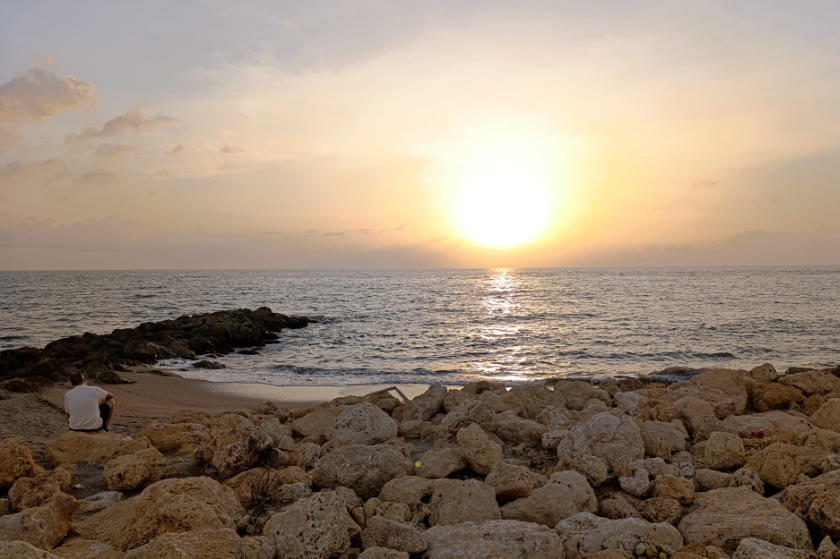
Photo by Travelhapp, Sunset Cartagena Colombia
Is Cartagena safe to visit? Cartagena can be considered reasonably safe for solo travelers if you take the usual precautions. Tourist police is present in popular areas such as the Walled City, Getsemaní, and Bocagrande. Also have a look at my recommendations where to stay in Cartagena.
As in other big Colombian cities, it’s better to do your explorations by foot before the night falls and stay in populated and well lit areas. Hailing a taxi from the street is not recommended, rather book your transport service by app. Taxi alternatives like Uber often provide better service in Colombia. Check out my Safety Tips for Solo Travelers in Colombia and Solo Travel Guide.
Some activities, like hikes and expeditions in the nature, are better done in a group. On Facebook you’ll find dedicated groups for Colombia travelers.
Unfortunately, Cartagena has a bit of a reputation for ripping off tourists, but at least they don’t discriminate between Colombian and foreign travelers, haha. It’s always advisable to check prices carefully before making a purchase or placing an order in a restaurant or bar, and to double-check your bills. Of course, as always, these are just a few bad apples, and most people are great.
Cartagena features a tropical climate characterized by rather consistent temperatures throughout the year, with day temperatures ranging roughly from 28°C to 32°C (82.4 °F and 89.6°F) and night temperatures from 22 to 26°C (71.6-78.8°F). The month with most rain in Cartagena is typically October and the driest months are December to March. The air in Cartagena may get quite humid during rainy season.
The biggest music event in Cartagena is the International Music Festival (Cartagena Festival de Música – Website), which is usually held in January. It features different musical styles, from traditional and modern Colombian music to jazz, classical music, and more.
High season in Colombia is primarily during the Christmas period (approximately from December 15 to January 15) and Easter (the week before Easter Sunday). Additionally, there are many long weekends and bank holidays, which are usually set to Mondays in Colombia. If you prefer to avoid large crowds, it’s better to visit Cartagena during mid and low season. You can find more information in my article on the best time to visit Colombia.
Here are some potential easy to reach destinations from Cartagena.
Mompox (Mompós): Mompox is a truly unique cultural and historical destination and features some of the best examples of colonial architecture in Latin America. This laid-back town is built on an island in the Magdalena River and is surrounded by rich vegetation. A bus from Cartagena will take you to Mompox in about 6 hours. (Check details about the bus connection on Rome2Rio.) From Mompox you can get to beautiful Valledupar (see below) in just 4 hours.
Barranquilla and Santa Marta: From Mompox you may take another bus up North to Barranquilla (6h) or Santa Marta (8h). You can also go directly from Cartagena to Barranquilla (2,5h) or Santa Marta (4-5h, see Rome2Rio). Santa Marta is a great base for exploring the fascinating North of Colombia where you can find everything from dream beaches, to jungle, mountains and desert. Check out our suggestions for top things to do in Barranquilla and best things to do in Santa Marta.
Valledupar: There is a direct bus from Cartagena to hidden gem Valledupar which takes a little more than 7 hours (see connection on Rome2Rio). Valledupar is a charming off-the-beaten-track destination in Colombia’s North, featuring a beautiful old town and stunning surroundings. From Valledupar you can continue by bus to Riohacha to explore the extraordinary beautiful La Guajira peninsula. Discover what to do in amazing Valledupar.
Capurganá/Sapzurro: It’s possible to get from Cartagena to the little known Caribbean paradises Capurganá and Sapzurro, located at the border to Panama, without passing through Medellín. It requires some planning and several transits. You first have to get to Necocli or Turbo by bus (via Monteria), mini-bus or collective taxi, and then take a ferry or boat to Capurgana. Find out more about things to do in Capurganá and Sapzurro.
San Blas Islands (Panama): Sailing boats leave from Cartagena to the iconic San Blas islands in Panama (5-day one-way trip, or round trip). A unique experience!
Share:
Last Update: November 17, 2025
*Affiliate links: Some links on this page are affiliate links. If you choose to book through these links, you support my work on Travelhapp – at no extra cost to you. I only recommend products and services I trust and believe will provide value to you.
© 2025 Travelhapp.com
To provide the best experiences, we use technologies like cookies to store and/or access device information. Consenting to these technologies will allow us to process data such as browsing behavior or unique IDs on this site. Not consenting or withdrawing consent, may adversely affect certain features and functions. View our Privacy & Cookie Policy